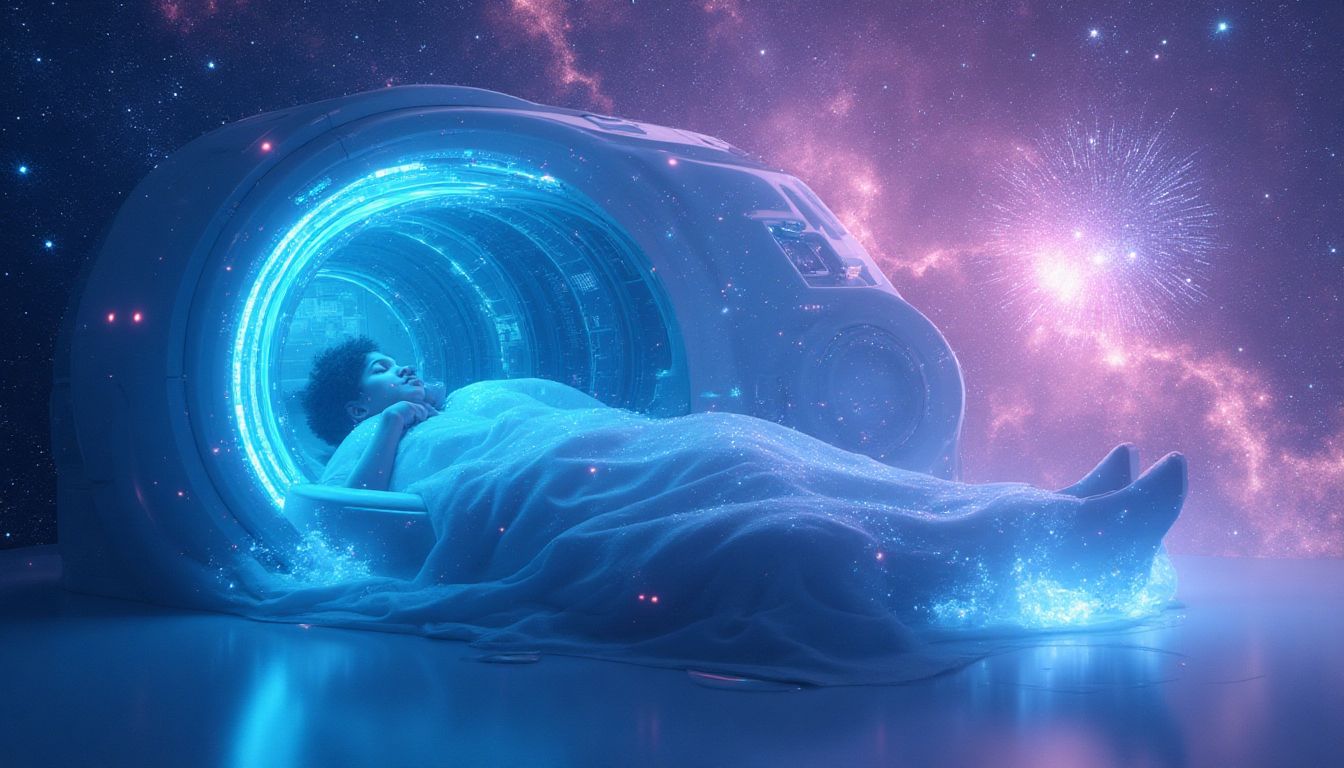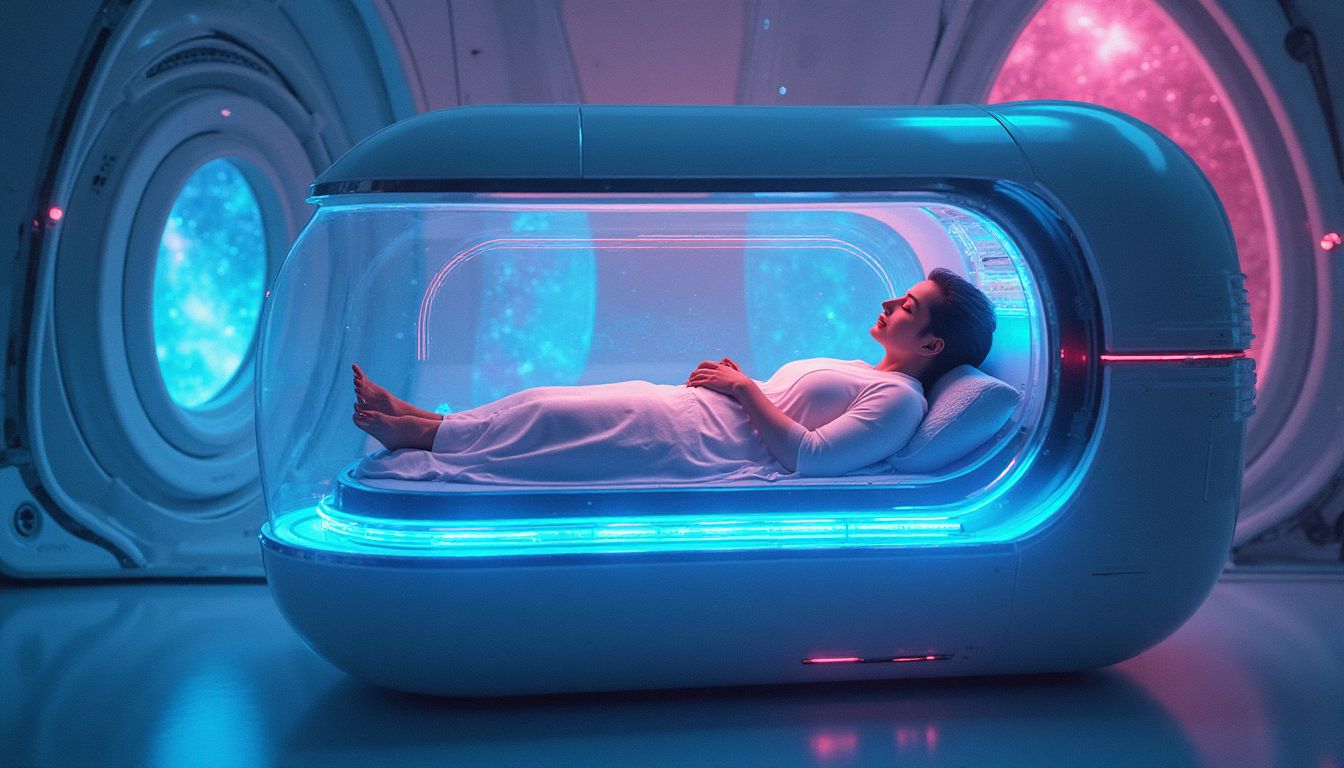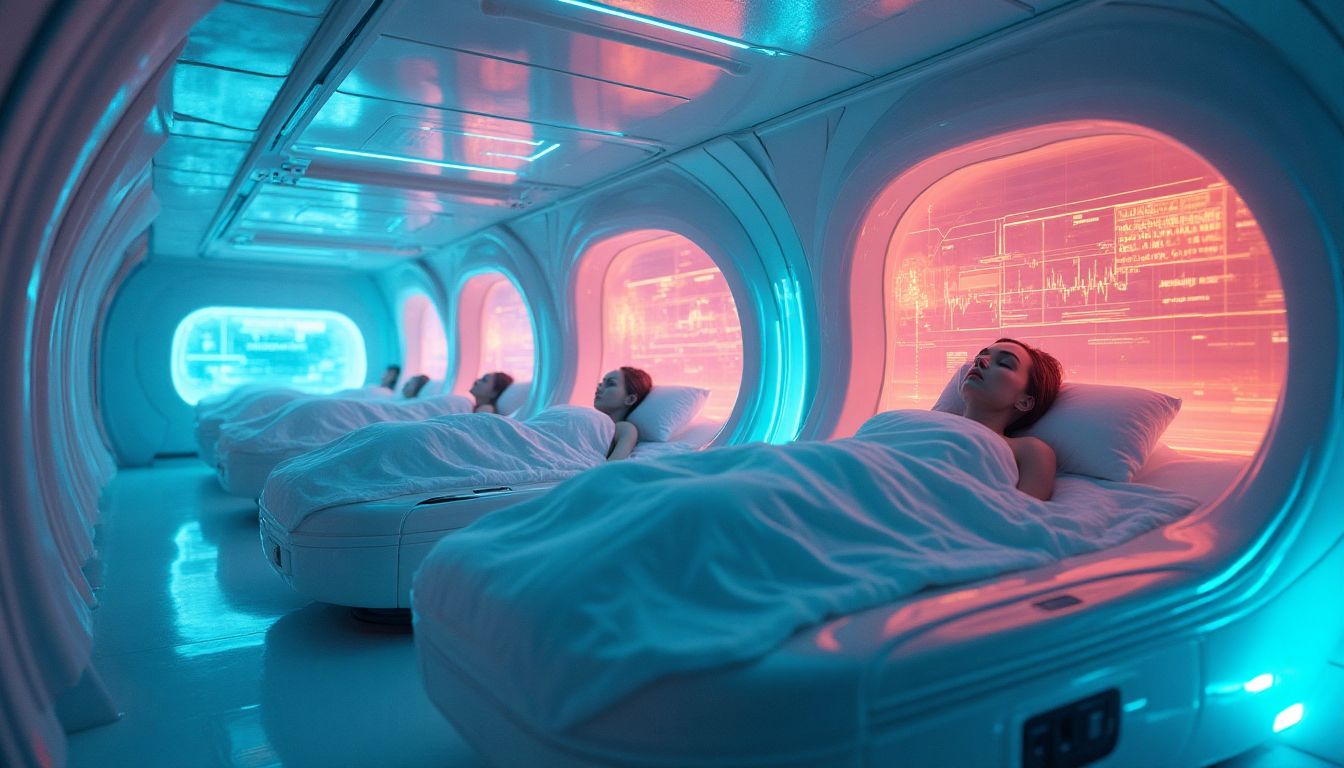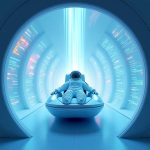Introduction: The Cryosleep Revolution
Exploration is wired into our brains. If we can see the horizon, we want to know what's beyond. – Buzz Aldrin. Humanity's curiosity knows no bounds. We're driven by an insatiable urge to peer into the unknown, to discover what lies in the uncharted territories beyond our blue planet. The stars beckon us, whispering promises of new worlds and discoveries. But these journeys raise many questions.
How do we, fragile beings of flesh and bone, undertake voyages of such magnitude? Enter AI-supported cryosleep, the bridge between science fiction and reality, bringing cosmic destinations within our reach. This revolutionary idea, championed by giants like Carl Sagan, Arthur C. Clarke, and NASA, promises the audacious dream of traveling to the stars without surrendering years of our lives.
Will artificial intelligence refine the boundaries of human hibernation and ensure our safe passage through the cosmos? Let’s unravel how this dream could become a reality.
The Science of Cryosleep: Mechanisms and Feasibility
To sleep perchance to dream...or to journey across the universe. The mechanics of cryosleep resemble science fiction, yet the underpinnings are deeply rooted in scientific inquiry and impassioned study. Forget magic potions; this is the realm of biology and technology, a sweet symphony working to pause life itself.
At its core, cryosleep asks: Can we slow down the human body to a crawl—and then restart? The science behind it involves metabolic suppression; by lowering the body’s temperature, we achieve a state of suspended animation. Imagine a digital pause button on life—with AI as the clever conductor.
Today's techniques employ exhilarating groundbreaking methods. Ever heard of cryoprotectants? They’re like tiny superheroes defending our cells against freezing temperatures. Scientists, inspired by nature’s champions like hibernating bears and frogs, are figuring out the best dance steps to make space hibernation possible. Yet, how does one awaken from this deep slumber? Picture a cosmic combo of biological defrost settings and AI precision, ensuring you don’t just thaw but thrive.
The Basics of Hibernation
Animals might have first cracked the code on hibernation. Bears, marmots, even bats—they’ve been doing it for millennia! Slowing their heartbeats and reducing energy needs—I dare say Mother Nature was ahead of her time. Their biological dance allows a deep rest during harsh winters while the rest of the animal kingdom hustles. Scientists are keen to transfer these instincts to humans, with a dash of techno-wizardry.
Current Cryogenic Techniques
Our modern methods are a thrilling cavalcade of innovation. Cryonics companies like Alcor, once a trove of rich imaginations, are trying to find their way from fascinating theory to triumphant application. Successes are mere stepping stones in this frozen frontier. The body, willingly suspended, must awaken whole on the other side. While a full victory in flawless human thaw remains on the horizon, the march toward safe stasis is steady and, with AI’s help, sure.
Psychological and Physiological Implications of Long-Term Hibernation
Prolonged hibernation presents a unique blend of challenges and questions that span beyond biology. It's much like trying to take a really long nap and waking up years later, still clutching your worn-out teddy bear—only with space travel involved. Sounds fun, right? But not so fast, Rip Van Winkle! The psychological and physiological impacts of long-term hibernation could be as mysterious as the dark side of the moon.
Effects on Mental Health
Imagine napping through birthdays, holidays, and the entire season of your favorite Netflix series. While hibernation skips through time like a fast-forward button on life, the psychological ramifications cannot be condensed into a simple “pause and play.” Loneliness and depression loom large. The post-hibernation confusion might not just be bewilderment over missing the Kardashian's latest antics but deeper identity and existential issues. Scholars fear that the mental dissonance faced upon awakening could range from having forgotten your social security number to questioning the meaning of life itself.
In experiments, even the most introverted participants express discomfort when imagining isolation without the prospect of chatter or Wi-Fi. Sustaining sanity might become its own space odyssey. But, cheer up! Potential solutions, like guided meditation or interactive holograms, offer promise as mood stabilizers, helping keep astronauts' spirits from deflating like a misfired space balloon.
Physical Risks of Extended Hibernation
If mental health sounds challenging, hold onto your helmets because the physical hurdles of hibernation are just as steep. Extended inactivity can turn muscles into Jell-O and bones into chalk—think more "pudding astronaut" than "muscled Mars explorer."
Muscle atrophy and bone density loss present formidable obstructions. The famed "zero-gravity abs" may remain a fantasy.
Solutions to combat corpulent calamity during cryosleep could involve leveraging resistance bands and electromagnetic stimulation. Besides, it might be easier to watch your weight when you're, you know, 150 million kilometers from the nearest fast-food drive-thru.
While fixes are being cooked up like a space-aged buffet, it’s clear we must revolutionize our understanding of how bodies react to prolonged periods of not moving, both in mind and matter.
AI Technologies: Enhancing Hibernation Processes
Enter Artificial Intelligence—the digital knight riding its silicon steed—to save our slumbering astronauts. By harnessing the might of machine learning, AI transforms potential debacles into dreamland triumphs. No more fright about waking up into spacecraft pandemonium—all thanks to the meticulous oversight of intelligent algorithms.
AI in Monitoring Biological Data
Imagine AI as a benevolent butler, tending to astronauts as they snooze through the stars, tracking their health using elevated biosensors. From heart rate to glucose monitoring, nothing escapes AI’s electronic gaze.
As life support systems regulate themselves, AI acts as both safeguard and guardian—alert for any alarms, poised to awaken astronauts from their peaceful slumber if needed. This tech adds a level of control and adaptability far beyond coffee-fueled human decision-making—all within a spacecraft that sometimes feels more capsule than carnival cruise.
Tailored Interventions Through Data Analytics
Thanks to AI, one-size-fits-all solutions might become relics of the past, like floppy disks and dial-up modems. By leveraging data analytics and historical data, AI navigates uncharted waters by predicting who among the hibernators needs what.
Imagine customized sleep pods that adjust to individual needs, tackling all—from nutrient deficits to replenishing electrolytes—thus managing the unique requirements of each astronaut. Using a delightful algorithm, AI ensures a balanced diet free from the constraints of freeze-dried ice cream and zero-gravity peanut butter.
The interplay between real-time analytics and AI adaptation spells a comfort zone where survival and serenity find peace. Say goodbye to stasis-related worries and hello to the veritable oasis of space-age dormancy.
Engineering the Dream: Designing Cryosleep Chambers
Designing cryosleep chambers is akin to crafting the vessel that may one day ferry humankind to unexplored realms.
Imagine a cocoon that envelops you safely for years, only to open at the dawn of a new world.
The intricacies in creating such chambers demand a fusion of advanced technology, **ingenious engineering**, and **creative design**.
Each component must not only function independently but also harmonize with the whole system to ensure safety and efficacy.
Material Considerations
At the heart of crafting cryosleep chambers is the selection of materials. These materials must withstand extreme conditions of space and provide optimal insulation to maintain the cryogenic state. Advances in
nanomaterials
and
smart textiles
are critical here, offering lightness, durability, and biocompatibility.
Some key considerations include:
- Insulation efficiency to maintain a stable cryogenic environment
- Durability against micrometeoroid impacts
- Non-toxicity and compatibility with human biology
For example,
European Space Agency
research into self-healing materials could prevent damage-related leaks. This integration ensures multiple layers of protection, allowing chambers to be more than just a shell—they become resilient guardians.
Prototype Designs
Analyzing existing frameworks and pushing the boundaries of design, architects and engineers are exploring concepts that might redefine space travel. Drawing from successful prototypes like
Habitat prototypes,
new designs incorporate AI-driven systems, advanced life support, and modular structures.
Some potential features of advanced cryosleep chambers might include:
- Integrated AI systems to regulate temperatures and monitor occupant health
- Modular designs to streamline repairs and updates
- Communication systems to allow for interaction with fellow astronauts or mission control
Designers envision a future where cryosleep chambers aren't just functional, but sophisticated life support systems that cater to human needs and interstellar dreams.
Ethical Considerations and the Future of AI-Cryosleep Integration
While the technological marvel of AI-cryosleep integration is a beacon of hope, it also brings forth ethical quandaries.
Innovation often outpaces regulation, posing challenging questions about the morality, legality, and societal impact of the leap into suspended animation.
As creators of these systems, developers hold immense responsibility to weigh technical feasibility against ethical integrity.
The Ethics of Hibernation
As we gaze into the future, ethical considerations raise profound questions about consent and human rights. When subjecting oneself to profound hibernation, what constitutes informed consent?
Does the individual truly understand the risks and ramifications involved in this deep freeze state? Transparency and thorough understanding are prerequisites for any such endeavor.
Ethical dilemmas also involve the mental states of those waking after potentially decades in hibernation. What psychological impact does long-term detachment from society and loved ones entail?
Prominent philosophers and bioethicists, such as those at the
Oxford Martin School,
are actively tackling these questions by formulating frameworks for ethical guidelines.
The Regulatory Framework
The advent of cryosleep technology exceeds the purview of science; it transcends into legal territories. Crafting regulations to monitor and dictate its use is paramount to preventing unethical practices or unwanted dystopian futures.
Potential regulations should consider:
- Clear and enforceable consent processes
- Protocols for ethical oversight and continuous monitoring
- Guidelines for transparency in cryosleep technology developments
Bodies such as the
United Nations
and other international space agencies will likely need to coordinate efforts to develop cohesive strategies that address such challenges.
As we take steps toward deploying AI-cryosleep, we must diligently engage with these ethical prompts—they define not just the success of our missions but the kind of legacy we leave in humanity's celestial exploration.
AI Solutions: Optimizing the Cryosleep Experience
Imagine an AI that isn't just smart but ingenious—tailoring solutions to the complex challenges associated with AI-supported cryosleep. In this brave new world, AI would stand as a vigilant guardian over the hibernating astronauts, monitoring every heartbeat, every cell turnover, and ensuring their safety throughout their long cosmic journey. The AI could use advanced data analytics and adaptive algorithms to enhance safety and effectiveness, making decisions in real-time based on the nuances of each individual's biological feedback.
The integration of these AI systems into cryosleep technologies involves several key steps, ultimately refining the experience of human hibernation. Here are the pivotal elements of this ambitious plan:
- Multi-layered Monitoring: The AI must integrate with biosensors positioned throughout the hibernation chamber to track vital signs continuously. These could include heart rate, body temperature, metabolic rates, and even neural activity to predict how the body is responding to suspension. This data would flow into predictive algorithms that could instantly adapt pharmacological interventions or trigger alerts to ground control if parameters deviate.
- Personalized Protocol Creation: The AI, through machine learning, can analyze historical data from pre-trial subjects, developing tailored intervention protocols for future hibernators. This would mean no two hibernations are the same; each would be finely tuned to the needs of the individual based on factors like age, health status, and genetic predisposition.
- Real-time Troubleshooting: In the event of any anomalies, the AI must be equipped to respond on the fly. This could mean adjusting the temperature of the cryosleep chamber or initiating countermeasures against detected physiological distress. For this, AI would leverage deep learning models that draw from vast datasets, simulating numerous scenarios regarding human response to cryogenic conditions.
With such ambitious aims, a thorough Actions Schedule/Roadmap will be crafted, establishing a comprehensive timeline for the development and implementation of AI-supported cryosleep technologies.
Day 1: Assemble a core project team consisting of scientists, ethicists, engineers, AI specialists, and legal advisors. Partner institutions may include experts from NASA, MIT's Massachusetts Institute of Technology, and the ISS National Lab.
Day 2: Conduct an extensive literature review on current cryosleep research alongside applications of AI in cryobiology, collaborating with institutions like NASA's Jet Propulsion Laboratory to tap their engineering expertise.
Day 3: Formulate preliminary hypotheses related to integrating AI into hibernation processes. Engage in workshops that foster innovative ideas from diverse fields.
Week 1: Host brainstorming sessions between stakeholders and interdisciplinary experts. Present findings from the literature review and adjust hypotheses based on collaborative input.
Week 2: Start discussions with potential funding sources, exploring grants from organizations such as the National Science Foundation and private sector partnerships.
Week 3: Select top-tier scientists in cryobiology and AI; design initial phases for experimental trials, ensuring alignment with best ethical practices.
Month 1: Complete feasibility studies on cryosleep technology; document findings, and present them to stakeholders for feedback, considering institutions like the University of Washington for their contributions to biological research.
Month 2: Develop AI modeling simulations predicting physiological responses to cryosleep conditions. Collaborate with tech companies such as IBM to utilize their AI research capabilities.
Month 3: Initiate construction of prototype cryosleep chambers, ensuring compliance with existing safety standards, with input from the Centers for Disease Control and Prevention (CDC) regarding biological safety.
Year 1: Launch small-scale trials with biomimetic approaches in controlled lab environments, utilizing computational models to foresee outcomes. Engage universities like Stanford University for their regenerative medicine research.
Year 1.5: Conduct pilot studies on long-duration hibernation in animal models, referencing military research on survival strategies from groups such as DARPA.
Year 2: Finalize AI algorithms, secure regulatory approvals for human trials, and initiate the first human hibernation missions. Collaborate continuously with ethical review boards across participating universities.
Conclusion: The Next Frontier of Human Exploration
As we stand on the cusp of the cosmos, marrying AI with cryosleep technology unveils a groundbreaking pathway to make long-distance space travel a reality. The future of humanity could very well lie beyond the stars, with AI taking center stage to guide and protect us during this unprecedented journey. With every challenge faced—biological, psychological, ethical—we inch closer toward redefining the limits of exploration.
As we delve deeper into these innovations, we must remember to tread lightly, considering the implications that come with wielding such powerful technology. Each step forward is a testament to our ingenuity and a reminder of our responsibility to align our aspirations with our ethical foundations. The dream of interstellar travel is no longer confined to the pages of science fiction; it beckons us to new horizons.
How might this technology change the way we perceive time and life? Will we redefine our understanding of consciousness in moments lost to hibernation? As we ponder these questions, we invite you to share your thoughts. What excites or concerns you about the prospects of AI-supported cryosleep? Join in on the conversation in the comments below, and let us take this journey through the stars—together.
Frequently Asked Questions (FAQ)
-
What is cryosleep?
Cryosleep is a special state where a person's body slows down so much that they seem to be asleep. It's like a super deep sleep! This is done by cooling the body to reduce what is called metabolic activity, which means the body's functions work at a much slower rate. It helps astronauts stay in a safe, restful state during long journeys in space. -
How does AI enhance human hibernation?
Artificial Intelligence, or AI, plays an important role in making sure people can safely remain in cryosleep. It can:- Monitor vital signs like heart rate and body temperature to keep track of health.
- Adjust medications automatically to fit what the body needs at any given time.
- Use data from previous cases to help make better decisions for each person in cryosleep.
This constant monitoring helps ensure the safety and comfort of astronauts while they're in hibernation.
-
Are there ethical concerns regarding cryosleep technology?
Yes, there are many important ethical questions we need to consider. Some of these include:- How do we ensure everyone understands the risks of hibernation?
- What happens to a person’s identity and choices while they are in cryosleep?
- How do we get consent from people who want to go into hibernation?
These questions are crucial as we think about using cryosleep for space travel or other purposes.
-
What challenges must be overcome for successful cryosleep?
There are several hurdles we need to face, such as:- Dealing with health risks like muscle loss or weakened bones.
- Understanding the psychological effects of being asleep for a long time, like feeling lonely.
- Creating safe cryosleep chambers that can handle all the technical needs of hibernation.
- Navigating the laws and regulations that come with new technology.
-
Can cryosleep be applied to long-distance space travel?
Yes! Cryosleep could be key for exploring distant planets. With the support of AI to ensure safety, astronauts can enter hibernation and travel for years without aging or experiencing the time that passes during the journey. This opens up exciting possibilities for discovering new worlds!
Wait! There's more...check out our gripping short story that continues the journey: The Beginning
Disclaimer: This article may contain affiliate links. If you click on these links and make a purchase, we may receive a commission at no additional cost to you. Our recommendations and reviews are always independent and objective, aiming to provide you with the best information and resources.
Get Exclusive Stories, Photos, Art & Offers - Subscribe Today!





























Post Comment
You must be logged in to post a comment.